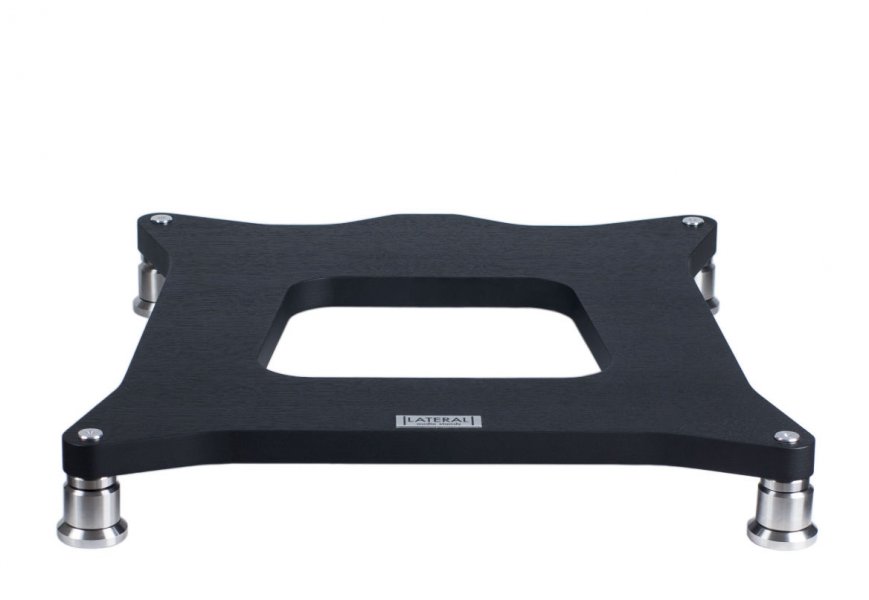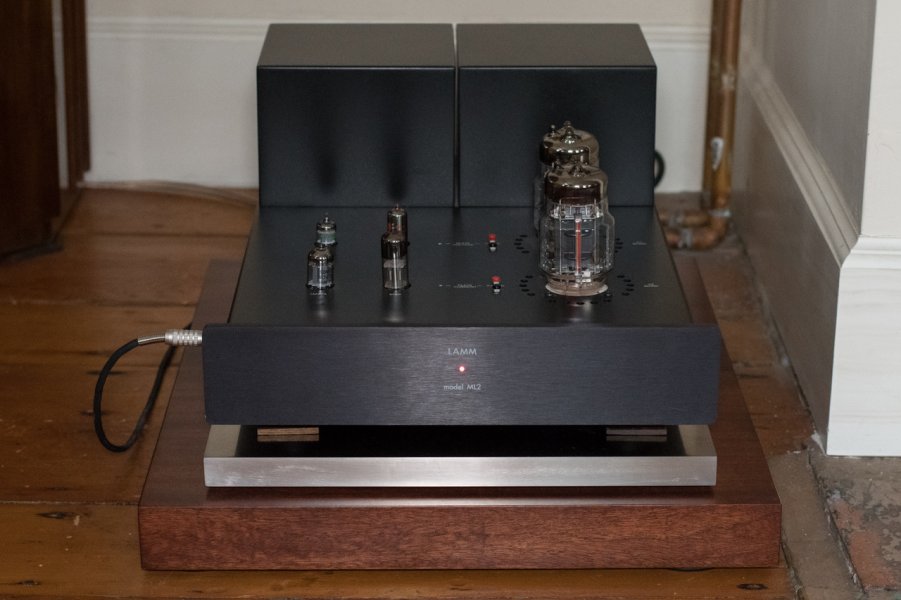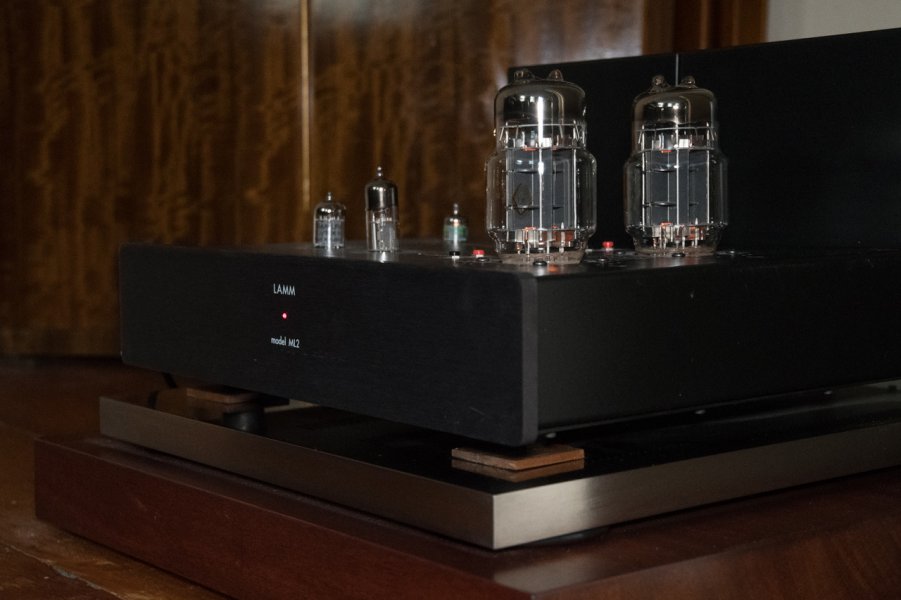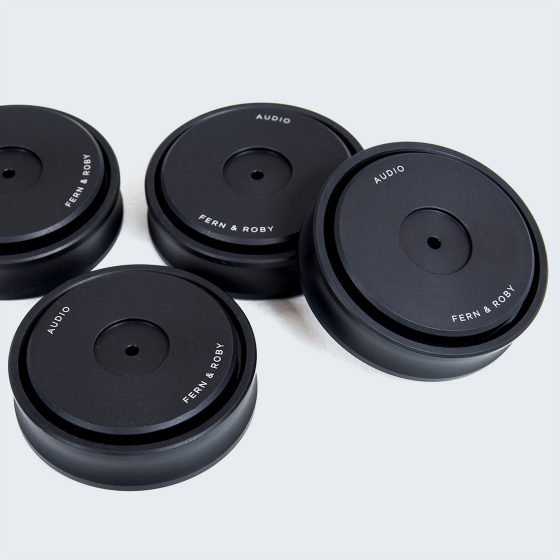All these different iterations and adjustments make it sound like you struggle to make steel work.Hello Brian, Here is a list of the different steel plates I've tried under my gear:
1. steel, 3/4" X 20" X 36", Kinetic systems ballast plate, unknown steel type
2. steel, 7/8" X 20" X 28", Kinetic systems ballast plate, unknown steel type
3. A36, 1" X 20 X 24", scrap from metal shop, painted by me.
4. #304 Stainless Steel, 1" X 14" X 18", sanded, polished finish by me.
5. #304 Stainless Steel, 2" X 15" X 17.5", sanded, polished finish by me.
6. #304 Stainless Steel, 2" X 15" X 8.5", sanded, polished finish by me.
I placed my SME turntable and Pass amps on all of the thinner steel plates and they all sounded different. I switched back and forth during my experiments. The plates from Kinetic systems were highly damped, while the A36 plate I made rang a lot. The #304 stainless that I now use for the Lamm gear are somewhere in between.
Size and proportions matter too. I have two different sized 2" #304 SS for my TT motor and main unit. They have a different number of supports/dampers under each. The supports/dampers under the 1" #304 SS plates for my electronics are different too. They all ring differently, so they need different amounts of dampening and tuning. The important thing is that the steel provides mass. You can then fine-tune the sound based on the type and dimension of steel you use.
I think we discussed using natural felt under the plates. I did not find that very effective, but it did work better on top under the stock component footers.
Amp Isolation Recommendations
- Thread starter kroslos
- Start date
You are using an out of date browser. It may not display this or other websites correctly.
You should upgrade or use an alternative browser.
You should upgrade or use an alternative browser.
All these different iterations and adjustments make it sound like you struggle to make steel work.
Well, isn’t a lot of DIY work a kind of struggle? This all came about kind of organically as stuff became available and my system was changing. The steel plate experiments began when I was using Vibraplane air isolation platforms. I added the steel ballast plates made by Kinetic systems. Then I determined that deflating the air sounded better in my system. Then I went to straight steel plates made from scrap and poorly finished. I had one cut up and painted it. Quick and dirty. (Bazelio would appreciate the effort) That worked fine too.
Then, after an outboard armpod project made from #304 stainless by a local machine shop, I tried #304 stainless steel for plates under preamps and phono stages. The experiments continued, and I settled on a dimension and a time consuming finish that satisfied the sound and appearance I was after. Now that I’ve gone through the exercise, I have specific ideas about what works and what doesn’t. It’s simply an alternative approach and I’m not making any form of recommendation to anyone. People should use what works for them and either DIY or buy a finished product.
It is certainly easier and less of a struggle to just buy some amp stands from one of the many audiophile brands that are discussed in the forums and advertised in magazines.
One of my friends uses HRS amp platforms and prefers them quite a bit to my steel plates. There are lots of alternatives as illustrated in the posts of this thread.
Last edited:
Steel and audio seem to be good friends ( thinking of these shelving plates and racks in general, tonearms etc. ). I want to try out some shelving plates such as mentioned.
On a tangent, the OP titled the thread 'amp isolation'. I am uncertain a chunk of metal under a component primarily counts as isolation, although that is a component of what is happening. Some audio companies claim to be simultaneously providing 'vibration drain' and 'isolation' which to my simple mind is akin to creating both a thermal mass and an insulator in one building material. Maybe its happening?
Great diy theme for the steel plates!
On a tangent, the OP titled the thread 'amp isolation'. I am uncertain a chunk of metal under a component primarily counts as isolation, although that is a component of what is happening. Some audio companies claim to be simultaneously providing 'vibration drain' and 'isolation' which to my simple mind is akin to creating both a thermal mass and an insulator in one building material. Maybe its happening?
Great diy theme for the steel plates!
Nice room and a beautiful system! Are those Chario speakers?
It appears you are set up in a relatively small room and the amplifiers are quite close to your speakers so I imagine there's a fair bit of airborne and floor borne energy in and around your system. I agree 100% with Folsom this can quickly become a rabbit hole........
That said since you're happy with your turntables isolation and did that rather inexpensively I get where you are coming from. IMHO, peace of mind, if not absolute improvement should not be hard to come by.
Fern and Roby makes a wonderful and affordable isolation kit of four pucks for $325 x 2 (1 set for each amplifier) that should yield a solid result and not mess with the stunning appearance of your Air Tight amplifiers. Give Cristopher Hiillibrand of Fern & Roby a call and see what he thinks. I would experiment using (3) and (4) of the pucks. As long as your doing this, I would try a set under your Accuphase drive. One might make a case to do this first as your drive is further up the chain and more prone to the deleterious effects of vibration.
Good luck!

 www.fernandroby.com
www.fernandroby.com
It appears you are set up in a relatively small room and the amplifiers are quite close to your speakers so I imagine there's a fair bit of airborne and floor borne energy in and around your system. I agree 100% with Folsom this can quickly become a rabbit hole........
That said since you're happy with your turntables isolation and did that rather inexpensively I get where you are coming from. IMHO, peace of mind, if not absolute improvement should not be hard to come by.
Fern and Roby makes a wonderful and affordable isolation kit of four pucks for $325 x 2 (1 set for each amplifier) that should yield a solid result and not mess with the stunning appearance of your Air Tight amplifiers. Give Cristopher Hiillibrand of Fern & Roby a call and see what he thinks. I would experiment using (3) and (4) of the pucks. As long as your doing this, I would try a set under your Accuphase drive. One might make a case to do this first as your drive is further up the chain and more prone to the deleterious effects of vibration.
Good luck!

Hifi Audio Isolation Feet — Fern & Roby
Enhance your audio experience with Fern & Roby's Isolation Feet. Perfect for turntables, speakers, and various audio components, these feet are expertly crafted to dampen vibrations, ensuring pristine sound quality. Designed to support heavy loads and compatible with spikes, rubber feet, or flat
Attachments
Some audio companies claim to be simultaneously providing 'vibration drain' and 'isolation' which to my simple mind is akin to creating both a thermal mass and an insulator in one building material. Maybe its happening?
SRA (Silent Running Audio) Ohio Class and Virginia Class platforms provide that top down, bottom up functionality on an equipment specific basis. The company makes very few claims and just lets their products do the talking. They don't need to advertise so we don't hear much about them.
Last edited:
...I have a pair of "Ohios" from SRA coming soon. These will replace the DIY pieces I made to experiment under my Luxman m900s:
Two 2" thick quartz slabs, and two 1 1/2" thick slabs of maple stock. There is a thin layer of "rubberized" sheet between the wood and quartz layers. They work and sound fine, but the look is a little too scrappy for my taste.
The SRA products are fabricated according to the weight of your components. I'm looking forward to swapping them in.
BTW: according to the folks that make the EVP pads (I use them under my MSB Reference dac and Daiza/Extreme): "Drain is not a thing."
Two 2" thick quartz slabs, and two 1 1/2" thick slabs of maple stock. There is a thin layer of "rubberized" sheet between the wood and quartz layers. They work and sound fine, but the look is a little too scrappy for my taste.
The SRA products are fabricated according to the weight of your components. I'm looking forward to swapping them in.
BTW: according to the folks that make the EVP pads (I use them under my MSB Reference dac and Daiza/Extreme): "Drain is not a thing."
The SRA products are fabricated according to the weight of your components. I'm looking forward to swapping them in
It's actually a host of factors that make up their component specific design, including component materials and resonance frequencies. Let me know what you learn from yr Ohio Class platforms - take your time as their benefits are discovered.
SRA is the cream of the crop, but not sure it meets the poster who started this thread's "reasonably priced" test....I have a pair of "Ohios" from SRA coming soon. These will replace the DIY pieces I made to experiment under my Luxman m900s:
Two 2" thick quartz slabs, and two 1 1/2" thick slabs of maple stock. There is a thin layer of "rubberized" sheet between the wood and quartz layers. They work and sound fine, but the look is a little too scrappy for my taste.
The SRA products are fabricated according to the weight of your components. I'm looking forward to swapping them in.
BTW: according to the folks that make the EVP pads (I use them under my MSB Reference dac and Daiza/Extreme): "Drain is not a thing."
Hello Brian, Here is a list of the different steel plates I've tried under my gear:
1. steel, 3/4" X 20" X 36", Kinetic systems ballast plate, unknown steel type
2. steel, 7/8" X 20" X 28", Kinetic systems ballast plate, unknown steel type
3. A36, 1" X 20 X 24", scrap from metal shop, painted by me.
4. #304 Stainless Steel, 1" X 14" X 18", sanded, polished finish by me.
5. #304 Stainless Steel, 2" X 15" X 17.5", sanded, polished finish by me.
6. #304 Stainless Steel, 2" X 15" X 8.5", sanded, polished finish by me.
I placed my SME turntable and Pass amps on all of the thinner steel plates and they all sounded different. I switched back and forth during my experiments. The plates from Kinetic systems were highly damped, while the A36 plate I made rang a lot. The #304 stainless that I now use for the Lamm gear are somewhere in between.
Size and proportions matter too. I have two different sized 2" #304 SS for my TT motor and main unit. They have a different number of supports/dampers under each. The supports/dampers under the 1" #304 SS plates for my electronics are different too. They all ring differently, so they need different amounts of dampening and tuning. The important thing is that the steel provides mass. You can then fine-tune the sound based on the type and dimension of steel you use.
I think we discussed using natural felt under the plates. I did not find that very effective, but it did work better on top under the stock component footers.
I'm using A36. The sound is noticeably affected by the number, size, and placement of O-rings underneath, which dampen the ringing. I didn't like the result when the plate was super damped (via the knuckle test), and it did take a while to settle on the "right" configuration. The benefit of the steel plate approach - any steel plate - is having the flexibility tune the result.
SRA is the cream of the crop, but not sure it meets the poster who started this thread's "reasonably priced" test.
Yes, it probably does not meet the OPs need for a very low cost amp stand. Platforms built for specific components will not cost less than off-the-rack or diy solutions - but they are highly effective and have their own value. (Did you know that as long as the original size does not change, SRA will modify their platforms to suit a different product at no cost?) I was not recommending to him directly, only responding to Solypsa about products that isolate while addressing component vibrations. In a thread about 'Amp Isolation Recommendations' I don't think it is off topic to talk about what various products can or cannot do.
You want cheap? No need for an audiophile brand. Get two teak cutting boards and put some sorbathane pucks between them. Replace the pucks every year or so.
The foot (rubber ring or other) under any stand affect the performance. I have tried felt, rubber, steel balls, druzy beads, multi layers of wood, corian, acrylic, fiberglass. I think you can make about anything work to a decent level of satisfaction. Figuring out right and wrong can be tricky. I thought my preamp on a piece of plywood was good. It was better than on the top of my stand. 2 pieces was muddy. Corian was clear but hard. Then a friend brought Ultimate 7s by. Much better clarity when on 1 piece of plywood. I could not afford them. I tried my corian chunks with insulation or fiberglass. The insulation went the wrong way. The Druzy bead got me 70% of what the stillpoint did. Much better clarity. That was good enough for me. Especially since I had a $6 investment into making them.
My point is its trial and error with DIY. And it seems as such with other more expensive footers and shelves. Especially footers. People pour through them like power cables.
My point is its trial and error with DIY. And it seems as such with other more expensive footers and shelves. Especially footers. People pour through them like power cables.
The foot (rubber ring or other) under any stand affect the performance. I have tried felt, rubber, steel balls, druzy beads, multi layers of wood, corian, acrylic, fiberglass. I think you can make about anything work to a decent level of satisfaction. le pour through them like power cables.
Yes the foot below the plate audibly affects performance. I would not say anything can be made to work well though. Avoid Sorbathane like the plague, whether above, below, in between, preloaded or not. Keep it out of the same room as your audio equipment, IME! Aside from that, results will simply vary. For example, I found rubber O-Rings from McMaster Carr better than felt underneath steel plates. @ddk led me in the right direction on both accounts.
Last edited:
I don't like sorbothane either unless I am doing something such as sticking it on a metal frame to keep the metal from vibrating and making noise. I have also successfully used it to separate wires and keep vibration from entering them. But I fully agree, I have never had it do well as a footer or between plates that equipment sits on.Yes the foot below the plate audibly affects performance. I would not say anything can be made to work well though. Avoid Sorbathane like the plague, whether above, below, in between, preloaded or not. Keep it out of the same room as your audio equipment, IME! Aside from that, results will simply vary. For example, I found rubber O-Rings from McMaster Carr better than felt underneath steel plates. @ddk led me in the right direction on both accounts.
I'm going to look up those rubber O rings. There are so many variations of chemical makeup and sizes to rubber. Especially if you start considering delrin, silicon and other substances.
I actually don't like felt that much. Its usually a miss. If its good enough, I am probably using it because I also want the item to slide. Hence it is under the bottom braces of my rack and my tape machine stand. Those units get pushed around quite a bit.
Something I have done is to use copper plates on top and bottom the steel. This seemed to help quite a bit with any ringing effect. Use something between the plates however, so they don't come into direct contact with each other (Isodamp, cork, etc.)Well, isn’t a lot of DIY work a kind of struggle? This all came about kind of organically as stuff became available and my system was changing. The steel plate experiments began when I was using Vibraplane air isolation platforms. I added the steel ballast plates made by Kinetic systems. Then I determined that deflating the air sounded better in my system. Then I went to straight steel plates made from scrap and poorly finished. I had one cut up and painted it. Quick and dirty. (Bazelio would appreciate the effort) That worked fine too.
Then, after an outboard armpod project made from #304 stainless by a local machine shop, I tried #304 stainless steel for plates under preamps and phono stages. The experiments continued, and I settled on a dimension and a time consuming finish that satisfied the sound and appearance I was after. Now that I’ve gone through the exercise, I have specific ideas about what works and what doesn’t. It’s simply an alternative approach and I’m not making any form of recommendation to anyone. People should use what works for them and either DIY or buy a finished product.
It is certainly easier and less of a struggle to just buy some amp stands from one of the many audiophile brands that are discussed in the forums and advertised in magazines.
One of my friends uses HRS amp platforms and prefers them quite a bit to my steel plates. There are lots of alternatives as illustrated in the posts of this thread.
Something I have done is to use copper plates on top and bottom the steel. This seemed to help quite a bit with any ringing effect. Use something between the plates however, so they don't come into direct contact with each other (Isodamp, cork, etc.)
that sounds like a great solution. I never tried it but considered it. Did you ever try a thin layer of natural felt between the two metal plates? I wonder if you added a third plate like aluminum.
I think Magico uses steel and copper an iso damp in combination for some of its footers and front baffles replacing the steel with aluminum.
Magico uses "aircraft grade" aluminum and copper. I have tried Isodamp, which worked. I have also used a simple but strong adhesive, JB Weld 8281, which I purchased from Home Depot.that sounds like a great solution. I never tried it but considered it. Did you ever try a thin layer of natural felt between the two metal plates? I wonder if you added a third plate like aluminum.
I think Magico uses steel and copper an iso damp in combination for some of its footers and front baffles replacing the steel with aluminum.
DIY seems like a lot to go through but if it's an enjoyable use of your time and effort, sure why not!
An alternate option would be a nicely constructed amplifier platform with inherently decent isolation e.g., from Adonis in Florida, then add any number of iso devices available from quite a few vendors tuned to the weight and resonant frequency of your amplifier(s). For a relatively affordable fully integrated solution take a look at this platform from Lateral Audio represented in the US by Brian Tucker of Pro Audio. Pricing runs $1700 - $2200 depending upon size, IMO quite reasonable given the thoughtful engineering and hiig quality construction.
Good luck!

An alternate option would be a nicely constructed amplifier platform with inherently decent isolation e.g., from Adonis in Florida, then add any number of iso devices available from quite a few vendors tuned to the weight and resonant frequency of your amplifier(s). For a relatively affordable fully integrated solution take a look at this platform from Lateral Audio represented in the US by Brian Tucker of Pro Audio. Pricing runs $1700 - $2200 depending upon size, IMO quite reasonable given the thoughtful engineering and hiig quality construction.
Good luck!

@gleeds, do you mean Adona Audio Solutions?An alternate option would be a nicely constructed amplifier platform with inherently decent isolation e.g., from Adonis in Florida
Similar threads
- Replies
- 52
- Views
- 4K
- Replies
- 0
- Views
- 1K
- Replies
- 3
- Views
- 1K
- Replies
- 36
- Views
- 7K
| Steve Williams Site Founder | Site Owner | Administrator | Ron Resnick Site Owner | Administrator | Julian (The Fixer) Website Build | Marketing Managersing |









